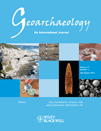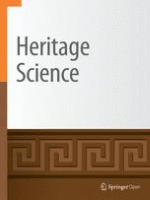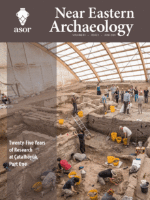
Interdisciplinaria Archaeologica-Natural Sciences in Archaeology
Scope & Guideline
Uncovering the Past with Scientific Precision
Introduction
Aims and Scopes
- Interdisciplinary Research:
The journal emphasizes interdisciplinary collaboration, integrating methodologies from archaeology, geology, chemistry, biology, and environmental science to enhance the understanding of past human behaviors and environments. - Innovative Analytical Techniques:
There is a strong focus on the application of cutting-edge scientific techniques, such as X-ray fluorescence, stable isotope analysis, and geophysical surveys, to analyze archaeological materials and contexts. - Cultural and Environmental Interactions:
Research often explores the interactions between ancient cultures and their environments, including studies on diet, resource use, and the impact of anthropogenic activities on landscapes. - Material Culture Studies:
Investigations into material culture, including ceramics, metalwork, and organic remains, are central to the journal's scope, providing insights into technological practices and social dynamics of past societies. - Geoarchaeology:
The journal promotes geoarchaeological studies, examining how geological and environmental factors influence archaeological findings and interpretations.
Trending and Emerging
- Application of Isotope Analysis:
There is a growing emphasis on isotopic studies, particularly in understanding dietary practices and migration patterns, highlighting their importance in reconstructing past human behaviors. - Geo-environmental Studies:
Research focusing on geo-environmental factors, such as the impact of climate and geography on human activities, is increasingly prominent, reflecting an interest in how environmental changes have shaped archaeological findings. - Non-invasive Archaeological Techniques:
The rise of non-invasive techniques, including geophysical surveys and remote sensing, is becoming a key trend, allowing researchers to gather data without disturbing archaeological sites. - Interdisciplinary Collaborations:
There is a noticeable trend towards collaborations between archaeologists and scientists from other disciplines, enhancing the depth and breadth of archaeological research. - Sustainability and Environmental Archaeology:
Emerging studies are increasingly addressing themes of sustainability and the environmental impact of ancient societies, reflecting a modern concern for ecological issues within the archaeological narrative.
Declining or Waning
- Traditional Archaeological Methods:
There has been a noticeable decrease in papers centered around traditional excavation methodologies without the integration of scientific analysis, as the field moves towards more data-driven and interdisciplinary approaches. - Descriptive Studies of Artefacts:
Papers that primarily describe artefacts without employing advanced analytical techniques are becoming less common, reflecting a shift towards studies that incorporate scientific methods for deeper insights. - Regional Studies without Comparative Analysis:
Research focused solely on specific geographical regions without comparative studies or broader contextual frameworks is diminishing, as the journal encourages more integrative and global perspectives.
Similar Journals

Studijne Zvesti Archeologickeho Ustavu Slovenskej Akademie Vied
Innovating methodologies for a deeper understanding of archaeology.Studijne Zvesti Archeologickeho Ustavu Slovenskej Akademie Vied is a leading journal in the field of archaeology, published by the SLOVENSKA AKAD VIED, ARCHEOLOGICKY USTAV, based in Nitra, Slovakia. This esteemed journal, with the ISSN 0560-2793, has established itself as a vital resource for scholars and researchers, reflecting significant academic contributions in both the arts and humanities as well as social sciences. With a 2023 Scopus ranking placing it in the second quartile (Q2) for archaeology, it showcases rigorous research and innovative methodologies, essential for advancing archaeological studies. While it is not an Open Access journal, it continues to offer valuable insights into archaeological findings, theoretical frameworks, and interdisciplinary approaches. The journal serves as a bridge, connecting local Slovak archaeology with international discourse, making it an indispensable tool for students, professionals, and academics striving for a deeper understanding of the archaeological heritage of Slovakia and beyond.

Archaeologia Baltica
Uncovering the Rich Tapestry of Baltic HistoryArchaeologia Baltica, published by the Institute of Baltic Region History & Archaeology at Klaipeda University, stands as a premier platform in the field of archaeology, with a specific focus on the Baltic region. This esteemed journal, which boasts a Q1 ranking in both the Arts and Humanities and Archaeology categories as of 2023, serves as a critical resource for scholars, researchers, and students dedicated to the exploration of archaeological horizons. Featuring an array of original research articles, reviews, and theoretical discussions, it aims to advance knowledge and foster dialogue in the diverse fields of archaeology. Though currently not an open-access publication, Archaeologia Baltica enjoys a commendable position in the Scopus rankings, underscoring its importance in shaping contemporary archaeological discourse. The journal not only reflects rigorous academic standards but also invites contributions that encourage collaborative efforts in the study of our shared cultural heritage.

GEOARCHAEOLOGY-AN INTERNATIONAL JOURNAL
Exploring the Intersections of Earth and HumanityGEOARCHAEOLOGY-AN INTERNATIONAL JOURNAL is a leading peer-reviewed publication dedicated to the interdisciplinary study of the interactions between geology and archaeology. Published by Wiley in the United States, this esteemed journal serves as a vital platform for researchers and professionals in the fields of archaeology, earth sciences, and environmental studies. With an impressive impact factor and categorized in the Q1 quartile of subjects such as Archaeology and Earth and Planetary Sciences, it ranks among the top journals in its discipline, reflecting its significant contribution to academic discourse and research innovations. Since its inception in 1986 and projected to continue into 2024, GEOARCHAEOLOGY emphasizes the importance of integrating geological methods within archaeological research, fostering a deeper understanding of human history in relation to the earth’s processes. This journal is an indispensable resource for scholars and students alike who seek to explore the dynamic connections between past human behavior and the geological record.

Heritage Science
Leading the Way in Innovative Heritage ResearchHeritage Science is a prestigious open-access journal, published by Springer since 2013, dedicated to the fields of heritage conservation and archaeology. With an ISSN of 2050-7445, it offers a platform for innovative research and critical discussions, encompassing interdisciplinary approaches that bridge the gap between art, science, and technology. The journal proudly ranks in the Q1 category for both Archaeology (arts and humanities) and Conservation, highlighting its influence and reputation within these scholarly realms. Furthermore, its presence in Scopus with impressive percentile rankings—such as #7 in Conservation and #23 in Archaeology (arts and humanities)—asserts its role as a leading voice in heritage studies. The journal's commitment to open access enhances the dissemination of knowledge, making it an essential resource for researchers, professionals, and students engaged in the preservation and interpretation of cultural heritage. Heritage Science continues to set standards in research quality, encouraging contributions that advance the understanding and sustainability of our shared heritage.

NEAR EASTERN ARCHAEOLOGY
Bridging Past and Present Through Archaeological InquiryNEAR EASTERN ARCHAEOLOGY, published by University of Chicago Press, is a premier journal dedicated to the field of archaeology, particularly focusing on the rich cultural heritage and archaeological findings of the Near East. With an ISSN of 1094-2076 and an E-ISSN of 2325-5404, this esteemed publication provides a vital platform for scholars and practitioners to share their research, insights, and discoveries. The journal holds an impressive ranking in the Q1 quartile for both Archaeology and History in 2023, reflecting its significant impact within these fields and a robust history of scholarly contribution. The journal has been pivotal in shaping discussions around archaeological methodology, theory, and contemporary issues from 2002 to 2024, as it continues to reach a wide audience through various access options. With Scopus rankings placing it in the top percentiles for both History and Archaeology, NEAR EASTERN ARCHAEOLOGY represents an essential resource for researchers, professionals, and students alike, fostering the exploration and understanding of the region's archaeological narrative.

Cuadernos de Prehistoria y Arqueologia-Universidad Autonoma de Madrid
Bridging Disciplines in Prehistoric StudiesCuadernos de Prehistoria y Arqueologia-Universidad Autonoma de Madrid is a distinguished academic journal dedicated to the fields of archaeology and prehistory, published by the Universidad Autonoma de Madrid, Departamento de Prehistoria y Arqueología. With an ISSN of 0211-1608, this journal plays a crucial role in disseminating significant research findings and theoretical advancements within these domains. Recognized for its scholarly excellence, it holds impressive quartile rankings in 2023, including Q2 in Archaeology and Q1 in History, reflecting its high impact within the academic community. While currently not an open-access publication, Cuadernos de Prehistoria y Arqueologia provides valuable insights to researchers, professionals, and students engaged in the exploration of human history and cultural heritage from 2018 to 2024 and beyond. With a commitment to fostering interdisciplinary dialogue, this journal serves as an essential platform for innovative studies and comprehensive reviews, contributing to the advancement of knowledge in archaeology and prehistory.

Slovenska Archeologia
Pioneering research in the heart of Slovak archaeology.Slovenska Archeologia is a prominent journal published by the Slovak Academy of Sciences, Institute of Archaeology, dedicated to advancing the field of archaeology through rigorous scholarly research and insightful scholarship. With an ISSN of 1335-0102 and an E-ISSN of 2585-9145, this journal has been a vital platform for archaeologists and academics since its inception, converging its insightful publications from the years 2017 to 2023. Awarded a Q2 ranking in the field of archaeology across both arts and humanities categories, it holds a respectable position in the Scopus rankings, recognizing its contributions to the discipline. Based in Slovakia, the journal is an essential resource for professionals, researchers, and students interested in archaeological findings and methodologies. While it does not currently offer Open Access options, its commitment to promoting high-quality research makes it a valuable addition to the academic community.

Kiva-Journal of Southwestern Anthropology and History
Unveiling the Past: Insights from the SouthwestKiva - Journal of Southwestern Anthropology and History is a distinguished academic journal published by Routledge Journals, Taylor & Francis Ltd, that serves as a vital resource for scholars in the fields of anthropology, archaeology, and history. With an ISSN of 0023-1940 and an E-ISSN of 2051-6177, this journal has established itself as a significant avenue for scholarly communication since its inception in 1964. It consistently ranks in the top quartiles, including Q1 in Archaeology and Q2 in Anthropology, reflecting its high impact and rigorous peer-review process. Covering a wide array of topics pertinent to the Southwestern United States, Kiva invites original research articles, reviews, and methodological papers that advance understanding of the region's rich cultural heritage and historical narratives. While currently not open access, its commitment to disseminating quality research makes it an essential reading for researchers, professionals, and students aiming to explore the multifaceted dimensions of southwestern studies.

JOURNAL OF WORLD PREHISTORY
Exploring Humanity's Origins Through Rigorous ResearchJOURNAL OF WORLD PREHISTORY, published by SPRINGER, stands as a premier platform for disseminating pioneering research and scholarship in the field of archaeology. Boasting a prestigious Q1 status in Archeology and a remarkable 97th percentile ranking in its category, this journal has made significant contributions to the understanding of global prehistory since its inception in 1987. It serves as an invaluable resource for researchers, professionals, and students alike, providing access to high-quality articles that explore diverse archaeological methodologies, theoretical frameworks, and case studies. Although it is not an open-access journal, its impact and relevance continue to resonate within the academic community, fostering critical discussions and advancing knowledge in this vital discipline. With publications converging from 2006 and set to continue until 2024, the JOURNAL OF WORLD PREHISTORY remains committed to advancing archaeological research and enhancing interdisciplinary collaboration.

Oxford Journal of Archaeology
Uncovering the Past, Shaping the FutureOxford Journal of Archaeology is a prestigious peer-reviewed journal published by WILEY, dedicated to advancing the field of archaeology through innovative research and insightful discourse. Established in 1982, this journal has become a vital resource, showcasing high-impact studies that resonate within the arts and humanities, as well as interdisciplinary fields such as geography and planning. With an impressive Q1 ranking in both Archaeology and Arts & Humanities categories, and a Q2 ranking in Geography, Planning, and Development, the journal consistently maintains its reputation for excellence—evidenced by its ranking in the 81st percentile within the Scopus Arts and Humanities Archaeology category. The Oxford Journal of Archaeology not only provides scholars, professionals, and students with access to cutting-edge archaeological research but also encourages collaboration and dialogue among a diverse academic community. Although the journal does not currently offer Open Access, it remains a crucial platform for those seeking to expand their knowledge and impact in this dynamic field.